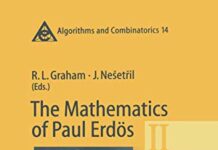
Ebook Info
- Published: 1990
- Number of pages: 208 pages
- Format: PDF
- File Size: 8.39 MB
- Authors: Ronald L. Graham
Description
Praise for the First Edition “Anyone interested in getting an introduction to Ramsey theorywill find this illuminating…” –MAA Reviews Covering all the major concepts, proofs, and theorems, theSecond Edition of Ramsey Theory is the ultimate guideto understanding every aspect of Shelah’s proof, as well asthe original proof of van der Waerden. The book offers a historicalperspective of Ramsey’s fundamental paper from 1930 andErdos’ and Szekeres’ article from 1935, while placingthe various theorems in the context of T. S. Motzkin’sthought on the subject of “Complete Disorder isImpossible.” Ramsey Theory, Second Edition includes new and excitingcoverage of Graph Ramsey Theory and Euclidean Ramsey Theory andalso relates Ramsey Theory to other areas in discrete mathematics.In addition, the book features the unprovability results of Parisand Harrington and the methods from topological dynamics pioneeredby Furstenburg. Featuring worked proofs and outside applications, RamseyTheory, Second Edition addresses: * Ramsey and density theorems on both broad and meticulousscales * Extentions and implications of van der Waerden’s Theorem,the Hales-Jewett Theorem, Roth’s Theorem, Rado’sTheorem, Szemeredi’s Theorem, and the Shelah Proof * Regular homogeneous and nonhomogeneous systems andequations * Special cases and broader interdisciplinary applications ofRamsey Theory principles An invaluable reference for professional mathematicians workingin discrete mathematics, combinatorics, and algorithms, RamseyTheory, Second Edition is the definitive work on thesubject.
User’s Reviews
Editorial Reviews: Review “Anyone interested in getting an introduction to Ramsey theory will find this illuminating…” (MAA Reviews, December 17, 2006) From the Publisher Ramsey theory has emerged as a cohesive subdiscipline of combinatorial analysis since about 1970. The present work comprises a self-contained exposition of the central results of Ramsey theory, describes recent developments in the field, and explores the influence of outside disciplines such as applications of topological dynamics and a combinatorial approach to undecidability results. New to the Second Edition is a complete treatment of Shelah’s 1987 proof as well as the original proof of Van der Waerden’s theorem. From the Inside Flap In 1987 Saharon Shelah was shown van der Waerden’s Theorem, a cornerstone of Ramsey Theory, and within several days found an entirely new proof that resolves one of the central questions of the theory. In this second edition of Ramsey Theory, three leading experts in the field give a complete treatment of Shelah’s proof as well as the original proof of van der Waerden. The text covers all the major concepts and theorems of Ramsey theory. The authors give full proofs, in many cases more than one proof of the major theorems. These include Ramsey’s Theorem, van der Waerden’s Theorem, the Hales-Jewett Theorem and Rado’s Theorem. A historical perspective is included of the fundamental papers of Ramsey in 1930, and of Erdos and Szekeres in 1935. The theme of Ramsey Theory, as stated by the late T.S. Motzkin, is “Complete Disorder Is Impossible.” Inside any large structure, no matter how chaotic, will lie a smaller substructure with great regularity. Throughout the authors place the different theorems in this context. This second edition deals with several other more detailed areas, including Graph Ramsey Theory and Euclidean Ramsey Theory, which have received substantial attention in recent years. The final chapter relates Ramsey Theory to areas other than discrete mathematics, including the unprovability results of Jeff Paris and Leo Harrington and the use of methods from topological dynamics pioneered by H. Furstenburg. Ramsey Theory, Second Edition is the definitive work on Ramsey Theory. It is an invaluable reference for professional mathematicians working in discrete mathematics, combinatorics, and algorithms. It also serves as an excellent introductory text for students taking graduate courses in these areas. From the Back Cover Wiley-Interscience Series in Discrete Mathematics and Optimization Advisory Editors: Ronald L. Graham, Jan Karel Lenstra, and Robert E. Tarjan Discrete mathematics, the study of finite structures, is one of the fastest-growing areas in mathematics. The wide applicability of its evolving techniques points to the rapidity with which the field is moving from its beginnings to its maturity, and reflects the ever-increasing interaction between discrete mathematics and computer science. This Series provides broad coverage of discrete mathematics and optimization, ranging over such fields as combinatorics, graph theory, enumeration, and the analysis of algorithms. The Wiley-Interscience Series in Discrete Mathematics and Optimization will be a substantial part of the record of the extraordinary development of this field. A complete listing of the titles in the Series appears on the inside front cover of this book.”[Integer and Combinatorial Optimization] is a major contribution to the literature of discrete programming. This text should be required reading for anybody who intends to research this area or even just to keep abreast of developments.” —Times Higher Education Supplement, London”An extensive but extremely well-written graduate text covering integer programming.” —American Mathematical MonthlyRecent titles in the Series include:Integer and Combinatorial Optimization George L. Nemhauser and Laurence A. Wolsey 1988 (0 471-82819-X) 763 pp.Introduction to the Theory of Error-Correcting Codes Second Edition Vera Pless For mathematicians, engineers, and computer scientists, here is an introduction to the theory of error-correcting codes, focusing on linear block codes. The book considers such codes as Hamming and Golay codes, correction of double errors, use of finite fields, cyclic codes, B.C.H. codes, weight distributions, and design of codes. In a second edition of the book, Pless offers thoroughly expanded coverage of nonbinary and cyclic codes. Some proofs have been simplified, and there are many more examples and problems. 1989 (0 471-61884-5) 224 pp. About the Author About the authors RONALD L. GRAHAM is Adjunct Director for Researchat AT&T Bell Laboratories, and University Professor of theMathematical Sciences at Rutgers University. He is coauthor ofConcrete Mathematics and of Old and New Problems in CombinatorialNumber Theory, and serves on the editorial boards of more than 25technical journals. He received his PhD in mathematics from theUniversity of California, Berkeley. BRUCE L. ROTHSCHILD isProfessor of Mathematics at the University of California, LosAngeles. He is Managing Editor of the Journal of CombinatorialTheory. He received his PhD in mathematics from Yale University.JOEL H. SPENCER is a professor of mathematics and computer scienceat the Courant Institute. He is the author of Ten Lectures on theProbabilistic Method and the editor of Random Structures andAlgorithms. He received his PhD in mathematics from HarvardUniversity. Read more
Reviews from Amazon users which were colected at the time this book was published on the website:
⭐
⭐
Keywords
Free Download Ramsey Theory, 2nd Edition 2nd Edition in PDF format
Ramsey Theory, 2nd Edition 2nd Edition PDF Free Download
Download Ramsey Theory, 2nd Edition 2nd Edition 1990 PDF Free
Ramsey Theory, 2nd Edition 2nd Edition 1990 PDF Free Download
Download Ramsey Theory, 2nd Edition 2nd Edition PDF
Free Download Ebook Ramsey Theory, 2nd Edition 2nd Edition

